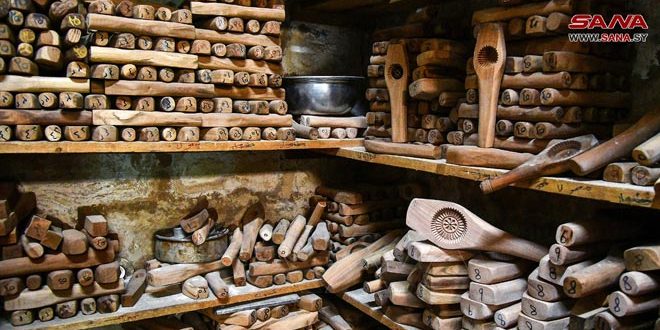The oldest factory of wooden molds for Maamoul which the ladies of Damascus used to boast of having the largest and most beautiful collection of them to make Eid sweets, is located in the center of old Damascus on the road between Bab Sharqi and Souk al-Bzouriya towards the minaret of al-Shahem.
Maamoul molds are frequently used during the month of Ramadan, Eid al-Fitr, and Eid al-Adha due to the rituals of making sweets that are widespread these days. The old wooden mold is still the tool of many families despite the spread of similar plastic molds because it gives a more beautiful shape to the Maamoul pieces and its dough becomes more firm according to the opinion of a number of its makers.
In a statement to SANA, Sheikh El-Kar Ayman Al-Nuwailati, 77, who inherited a 150-year-old craft in making Arabic confectionery tools, spoke of his great love and passion for this craft since his youth in the seventies of the last century. He recalled memories that he had with his father, Muhammad Al-Nuwailati, the old Damascene man who was known for making a tool out of the wood of durable apricot trees, which made it easier for homemakers, and sweet makers to make the most beautiful shapes of desserts in the holidays.
With regard to the forming stages of the Maamoul molds displayed in front of his shop, Al-Nuwailati mentioned that they are still making these molds manually, along with other types and forms of household supplies such as rolling pins, wooden spoons, and sieves, as well as some kitchen supplies such as garlic jars and kibbeh molds.
He went on to say that the mold industry relies on wood extracted from dry trees. If it is green, it is exposed to boiling temperature until the water comes out and then it is spread in the air to dry well for about three months to be treated to prevent cracks inside thereafter. The wood is then cut into small pieces and placed on the rabot machine that makes the wood texture smooth and then placed on the so-called Hindaza to be drawn and to determine the engraving center and dimensions of the mold that vary according to the customers’ desire and the fillings placed inside the Maamoul pieces.
The secret of the profession, according to Nuwailiti, is related to the technology of the lines and engravings that the craftsman designs so as to prevent the sticking of the Maamoul dough inside the mold, using tools that he has made some of them and keeps in the drawers of his antique cabinet to carve wood and inscribe details professionally. He pointed out that some factories and shops that manufacture famous Syrian sweets require that the factory name be engraved into the mold to become their own brand.
Nuwailiti fears that his craft will disappear and be lost after having accompanied Syrians for years and associated with their feast requirements. He is keen to teach his son the assets and secrets of the profession in the hope that he will learn it to complete the handicrafts in this area, while noting that the industry, despite it being very old, is active and thriving every Eid due to the high demand for it.
Amal Farhat

